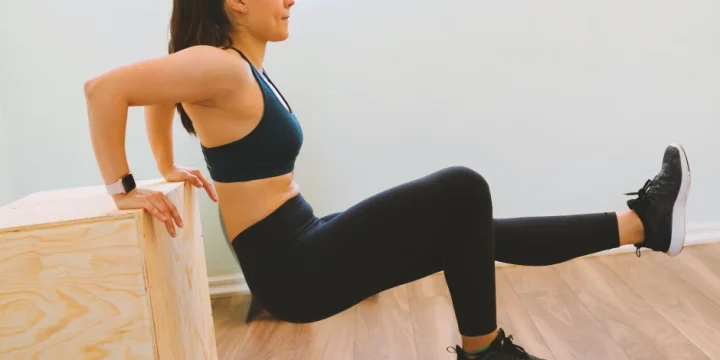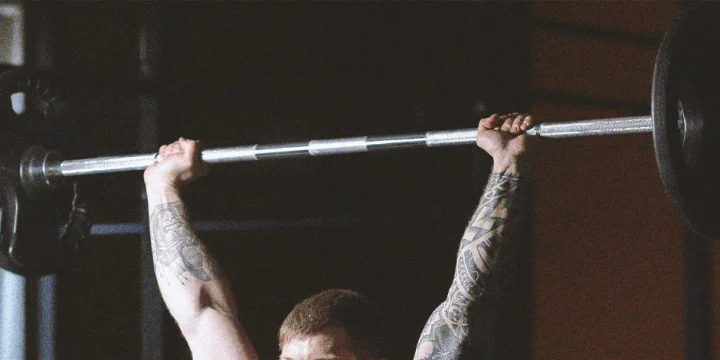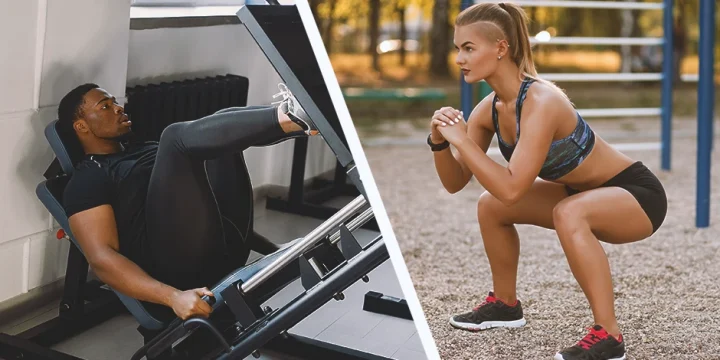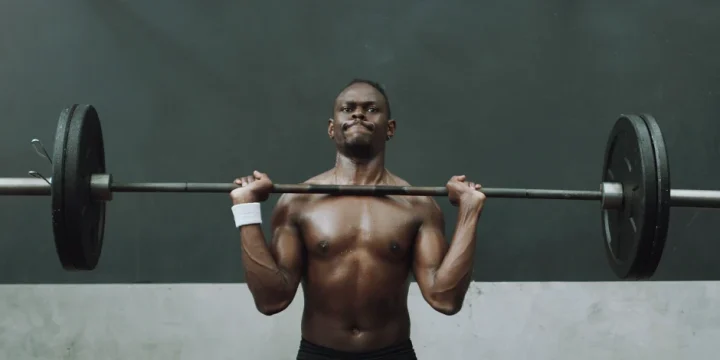The French press exercise is highly effective at strengthening and sculpting the triceps muscles, making it a go-to for my fitness clients, whether elite athletes or simply fitness enthusiasts.
Here, we will discuss how to perform the French press properly, variations, muscles worked, and tips to maximize the benefits of this versatile triceps exercise.
Let’s get started.
Quick Summary
- The French press exercise isolates the entire muscle, especially the long head of the triceps.
- Because of the standing starting position, French presses activate other muscles as stabilizers.
- According to a review from Physiotherapy Canada, stabilizer muscles support and stabilize exercise movements, controlling one joint so another can perform the intended movement.
- Though it is a triceps exercise, the French press can help tone the upper body if done properly.
What Is the French Press?

The French press is an isolation exercise and type of overhead triceps extension that involves standing with your feet shoulder-width apart while holding an angled EZ curl bar with an overhand grip.
Because the French press activates the glutes, deltoids, pecs, core, and lower back muscles as stabilizers, implementing them regularly into your workout routine will help strengthen and tone your upper body.
According to a review from Physiotherapy Canada, stabilizer muscles support and stabilize exercise movements, controlling one joint so another can perform the intended movement [1].
French Press Vs. Skull Crusher: What's the Difference?
Many people use the terms French press and skull crusher interchangeably, but they are different triceps exercises, with the significant difference being their starting position.
Traditionally, you perform French presses standing, whereas skull crushers work the upper arm from a lying position.
Additionally, French presses use an EZ bar, and skull crushers use dumbbells or barbells.
How To Do the French Press

If you are new to a French press workout, only load as much weight as is necessary to maintain proper form.
Remember that this exercise involves lifting a weight behind your head, so for safety, start light and add more weight as you master form and get stronger.
Here’s how to do it:
- Load a barbell or EZ bar with the appropriate weight and place it on the floor.
- Grasp the barbell with a comfortable grip, palms facing down, and your hands 8–12 inches apart.
- Stand upright, placing your feet shoulder-width apart with a slight bend in your knees.
- Lift the bar above your head while rotating your shoulders outward.
- Slightly bend your elbows to move the tension onto the triceps.
- Lower the bar behind your head as far as comfortably possible.
- Pause briefly at the bottom position.
- Raise your arms until they are fully extended, but do not lock your elbows out.
- Repeat for the desired number of reps.
Variations

Once you have perfected the standard exercise, try these French press variations.
1. Seated French Press
You will sit on a flat bench for the seated French press while raising the EZ curl bar overhead. The seated position lets you focus on your arms, taking pressure off your stabilizer muscles.
These stabilizer muscles include the glutes, core, lower back, pecs, and deltoids.
2. Lying French Press
Also called the lying triceps extension or skull crusher, the lying French press involves lying on your back on a flat bench as you would with a bench press.
With the lying French press, you lift the bar overhead while your torso is in a neutral position, supported by the bench, and with a slightly less range of motion than a traditional standing French press.
“I can do this with either a straight bar, cambered bar, dumbbells, cables, you can kind of do any technique you want, but this is going to give us an extension on the triceps.”
- Jay Cutler, Professional Bodybuilder
3. Dumbbell French Press
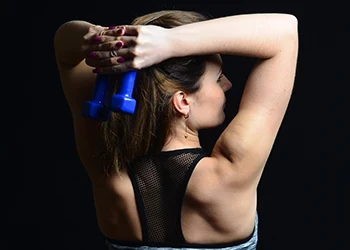
This French press variation uses dumbbells instead of the EZ curl bar, which can help with any muscle imbalance you may have from favoring one side over the other.
The starting position of the dumbbell French press can be standing with feet hip-width apart or lying on a flat bench.
4. Close Grip Bench Press
The movement pattern for the close-grip bench press is the same as a traditional bench press but with a narrower grip on the bar.
This close grip puts more emphasis on the triceps than a conventional bench press.
5. Incline Bench French Press
This French press variation utilizes a good cable machine with a straight bar or rope attachment.
You perform this variation seated, gripping the attachment with an overhand grip.
Though the movement pattern is the same as the traditional French press, the starting point is not. You’ll begin this tricep exercise with your hands behind your head.
Read More: Incline vs Flat Bench: Which One is Better
Tips For Proper Form
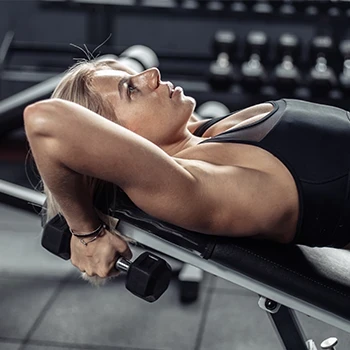
I've put together the following tips to maximize your tricep gains from the French press:
- Maintain correct technique throughout the movement, keeping elbows close to the body.
- Use a slow and controlled manner to perform each rep.
- Do not lock out the elbows at the top of the movement.
- Move only the forearms while keeping the body still.
- Keep your eyes forward and your head up during the exercise.
Benefits of French Presses
The French press is a great exercise, offering several benefits beyond aesthetic upper arms.
These include:
- Building stronger triceps by targeting the long head of the triceps muscles.
- Increasing overall stabilization, as the exercise requires muscles in your upper and lower body to be activated.
- Improving the performance of other exercises, such as deadlifts, pull-ups, close-grip bench presses, and push-ups.
Why Tricep Exercises are Important

The tricep is a three-headed muscle in the upper arms that primarily plays two vital roles.
First, the triceps help with elbow extension, which is critical to executing pressing movements. Second, they aid shoulder extension by pulling the arm down from overhead [2].
These are the three heads of the triceps:
- Lateral head: originates from the humerus
- Long head: originates from the scapula
- Medial head: originates from the humerus
The triceps muscle also helps stabilize the shoulders. The French Press isolates the entire muscle, but particularly the long head of the triceps.
“The triceps extend, or straighten, the elbow, as well as aid the shoulder muscles to extend the arm. The overhead tricep extension is an excellent exercise to work this muscle.”
- Travis Edwards MPT, BSc
Related Articles:
Work Out Safely and Avoid Injury

When executing French presses or any other exercise, follow these reminders to avoid injury and get the most out of your workout safely:
- Consult your doctor about any new exercise program to discuss any health conditions.
- Choose an appropriate weight that allows complete body control throughout the movement, mainly because this is an overhead press.
- Pay attention to your body. Stop the exercise immediately if you have any pain.
- Incorporate warm-ups, rest, and nutrition into an exercise program for optimal results.
- Allow 24–48 hours of recovery time between workouts to ensure progress and build strength.
- Many of my fitness clients utilize protein powder to enhance muscle repair, boost energy, and accelerate recovery times.
FAQs
Is It Better To Do the French Press Standing Or Seated?
It is better to do the French press standing to recruit other muscle groups besides the triceps; performing the exercise while standing activates the glutes, core, shoulder, and lower back muscles as stabilizers during the entire movement.
Is French Press the Same As Skull Crusher?
The French press is not the same as a skull crusher. The traditional French press exercise involves lifting an EZ curl bar overhead from a standing position. In contrast, you execute the skull crusher lying on a flat bench, lifting dumbbells or barbells.
References:
- https://utpjournals.press/doi/10.3138/ptc.2013-51
- https://www.ncbi.nlm.nih.gov/books/NBK536996/
About The Author
You May Also Like
